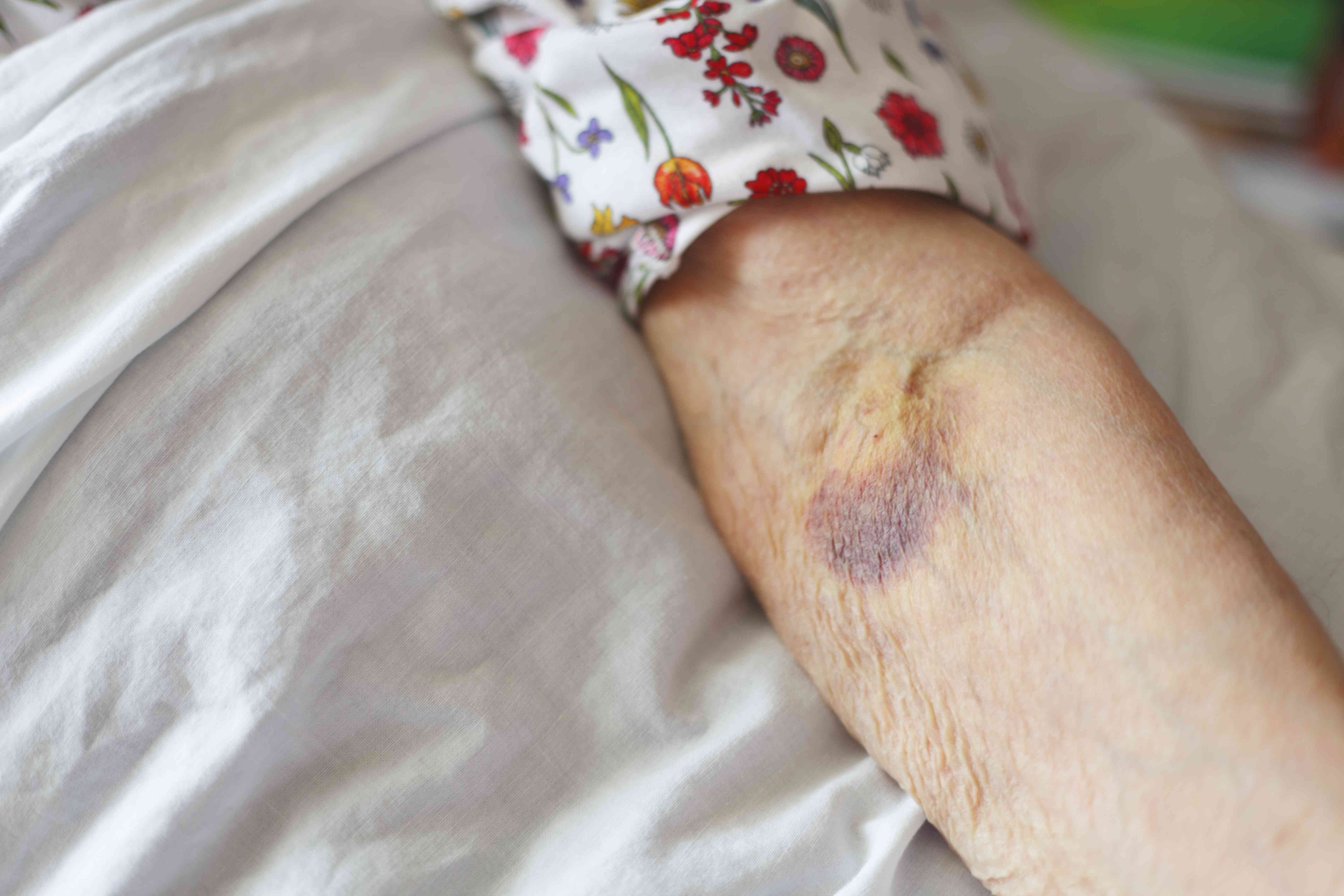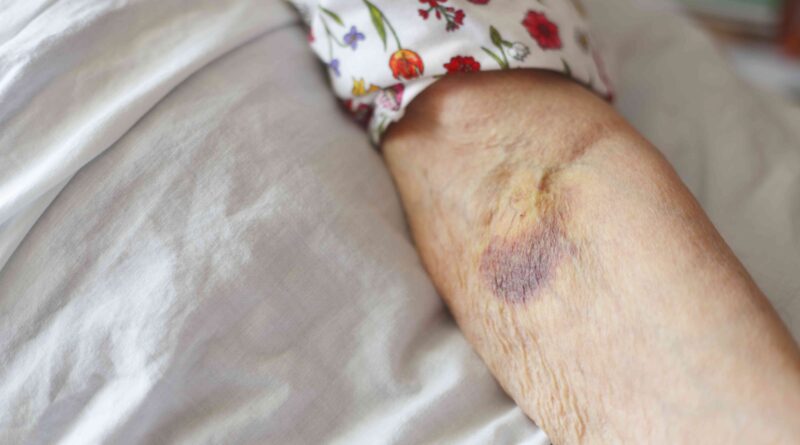Solar Purpura: Symptoms, Causes, Diagnosis, Treatment

Solar purpura is a condition that causes bruises to appear on the skin without any kind of injury or trauma. These bruises are harmless and don’t hurt because they’re not caused by an injury. If you develop them, you may notice bruises on the back of your hands and forearms.
Solar purpura often affects older adults, as solar purpura typically occurs due to long-term exposure to ultraviolet (UV) rays from the sun.
Bruising is the primary symptom of solar purpura, though you may also notice some changes to your skin in the areas surrounding the bruises.
Bruising
Many people with solar purpura have just one symptom: bruises that seem to appear randomly on their skin. Normally, bruising is a sign of trauma or injury. For example, when you fall down, you might break some of the blood vessels under the skin, and since the blood has nowhere to go, it pools there until your body eventually reabsorbs it.
People with solar purpura, however, often end up with bruises after normal, everyday activities or minor injuries that wouldn’t typically result in a bruise. Solar purpura bruises typically appear on the parts of the body most exposed to the sun, like the hands, arms, and face.
Most of the bruises are 1-4 centimeters (cm) in diameter, flat, and red or purple in color before gradually fading over a few weeks.
Skin Changes
Because solar purpura usually happens with aging and sun exposure, the skin around the bruises might show signs of damage and weakening. If you have solar purpura, your skin may also look thin, saggy, or wrinkly, have a yellowish hue, or have other evidence of aging and sun exposure, such as sunspots.
Aging and long-term sun exposure are the most common causes of solar purpura. Both factors can weaken the walls of the blood vessels over time and leave them prone to easy breakage. The blood collects around the broken blood vessels just like it does after an injury or trauma, making a bruise appear under the skin. However, a few other factors can also weaken blood vessels and cause solar purpura, such as:
Risk Factors
There are no risk factors for solar purpura other than its causes. In other words, aging, sun exposure, and use of certain substances are the only factors that increase your risk for the condition. However, your risk for solar purpura is higher when you have multiple risk factors. For example, prolonged sun exposure in an older adult can exacerbate solar purpura, and older adults who regularly take NSAIDs or drink alcohol are also more likely to have solar purpura.
If you’re concerned about sudden or random bruises that appear on your skin, seeing a healthcare provider is important. They can assess your bruises to make an accurate diagnosis of your condition. You can expect your provider to ask about your medical history and perform a physical exam during your appointment. This is typically enough to make a diagnosis.
In rare cases, your provider may refer you to a dermatologist (a medical doctor who specializes in skin, hair, and nail conditions) for a skin biopsy if they’re concerned about the bruises. A biopsy takes a sample of your skin tissue and helps provide a closer look at the top two layers of your skin—the epidermis and dermis—and assess how thick or thin your skin is. A biopsy can also rule out any other potential causes of your bruising.
You don’t need any treatment for solar purpura, as it’s a benign (non-harmful) condition that doesn’t cause any complications. The bruises heal on their own within three weeks, though they may recur throughout your life from time to time.
Some people look for treatments to speed up the healing process because they don’t like the appearance of bruises. However, there isn’t much evidence that topical medications provide much benefit. Retinoids have shown some effectiveness in reducing the bruised appearance, but the studies performed have been small, and the results weren’t overwhelmingly positive for the use of retinoic acid on bruises.
Certain topical skincare products (like ceramide, niacinamide, and arnica gel) may help improve your skin’s overall health, which could lead to less bruising or a quicker recovery time. However, the research on these products for solar purpura is minimal, so more studies are needed.
Experts generally recommend covering the bruises with clothing or makeup if you’re concerned about their appearance. Your healthcare provider or dermatologist can also recommend certain skincare items personalized for your skin’s overall health.
It may not be completely possible to prevent solar purpura, but the best way to reduce your risk of developing it as you age is to protect your skin from UV rays throughout your life. Consider the following sun protection tips:
- Wear a broad-spectrum sunscreen with an SPF of 50 or higher
- Keep your arms and legs covered with lightweight and breezy clothing
- Use a wide-brimmed hat or sunglasses to protect your scalp and eyes
You can take good care of your skin so it’s strong enough to handle minor trauma. In addition to protecting your skin from the sun, keep it moisturized, stay hydrated, quit or avoid smoking, and try to manage stress. You may also want to switch to gentler, hypoallergenic soaps and skincare products, use a humidifier to reduce dry air and wear gloves when you risk injuring your skin, such as while gardening.
Talk to your healthcare provider if medications like aspirin or blood thinners are causing your solar purpura. In some cases, they may be able to switch you to another medication or offer an alternative therapy that lowers your risk of skin changes.
Since solar purpura typically occurs due to aging and sun exposure, these risk factors can also increase your chances of other skin conditions, such as:
- Liver spots: Also known as lentigo, liver spots are a common sign of aging. These areas of pigmentation often look like large freckles and appear in the same places as solar purpura, like the back of your hand, forearm, and face.
- Actinic keratosis: These reddish patches are extremely common and caused by UV exposure. They typically appear on the face, scalp, hands, and ears. Unlike liver spots, actinic keratosis growths are precancerous, so it’s important to see a dermatologist regularly for skin cancer screenings.
Solar purpura is a harmless condition that doesn’t cause pain. While solar purpura is a sign that your skin has been exposed to the sun frequently or is undergoing age-related changes, the bruises are not a symptom of skin cancer or other skin diseases. The condition also doesn’t affect your life expectancy in any way.
However, the appearance of solar purpura is a sign that your skin is weakening, so you may want to take steps to strengthen your skin’s integrity. You can do this through a nourishing skincare regime and sun protection.





